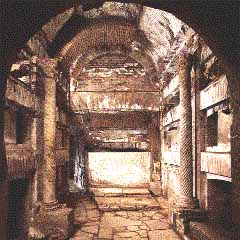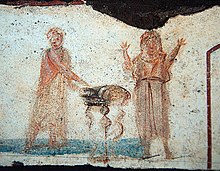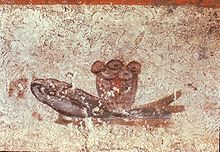Roman Catacombs 
History Precursors
Etruscans used to bury their dead in underground chambers. Christians revived the practice because they did not want to cremate their dead due to their belief in bodily resurrection. Hence they began to bury their dead, first in simple graves and sometimes in burial vaults of pro-Christian patricians.
Christian catacombs
The first large-scale catacombs were excavated from the 2nd century onwards. Originally they were carved through soft rock outside the boundaries of the city, because Roman law forbade burial places within city limits. At first they were used both for burial and the memorial services and celebrations of the anniversaries of Christian martyrs (following similar Roman customs). They probably were not used for regular worship. Many modern depictions of the catacombs show them as hiding places for Christian populations during times of persecution.
There are forty known subterranean burial chambers in Rome. They were built along Roman roads, like the Via Appia, the Via Ostiense, the Via Labicana, the Via Tiburtina, and the Via Nomentana. Names of the catacombs - like St Calixtus and St Sebastian alongside Via Appia - refer to martyrs that might be buried there.
Christian excavators (fossors) built vast systems of galleries and passages on top of each other. They lie 7-19 meters (22-65 ft) below the surface in area of more than 2.4 km (600 acres). Narrow steps that descend as many as four stories join the levels. Passages are about 2.5x1 meters (8x3 feet). Burial niches (loculi) were carved into walls. They are 40-60 cm (16-24 in) high and 120-150 cm (47-59 in) long. Bodies were placed in chambers in stone sarcophagi in their clothes and bound in linen. Then the chamber was sealed with a slab bearing the name, age and the day of death. Fresco decorations were typically Roman. The catacomb of Saint Agnes is a small church. Some families were able to construct cubicula which would house various loculi and the arquitectural elements of the space would be a support for decoration. Another excellent place for artistic programs were the arcosoliums.
Decline, sack and rediscovery
In 380, Christianity became a state religion. At first many still desired to be buried in chambers alongside martyrs. However, the practice of catacomb burial declined slowly, and the dead were increasingly buried in church cemeteries. In the 6th century catacombs were used only for martyrs' memorial services. Apparently Ostrogoths, Vandals and Lombards that sacked Rome also violated the catacombs, possibly looking for valuables. By the 10th century catacombs were practically abandoned, and holy relics were transferred to above-ground basilicas.
In the intervening centuries they remained forgotten until they were accidentally rediscovered in 1578, after which Antonio Bosio spent decades exploring and researching them for his volume, Roma Sotterranea (1632). Archeologist Giovanni Battista de Rossi (1822-1894) published the first extensive professional studies about catacombs. In 1956 and 1959 Italian authorities found more catacombs near Rome. The catacombs have become an important monument of the early Christian church.
Today Currently maintenance of the catacombs is in the hands of the Papacy which has invested the Salesians of Don Bosco the supervision of the Catacombs of St. Callixtus on the outskirts of Rome.
Typology
Roman catacombs are made up of underground passages (ambulacra), out of whose walls graves (loculi) were dug. These loculi, generally laid out vertically (pilae), could contain one or more bodies. Another type of burial, typical of Roman catacombs, was the arcosolium, consisting of a curved niche, enclosed under a carved horizontal marble slab. cubicula (burial rooms containing loculi all for one family) and cryptae (chapels decorated with frescoes) are also commonly found in catacomb passages. When space began to run out, other graves were also dug in the floor of the corridors - these graves are called formae.

History Precursors
Etruscans used to bury their dead in underground chambers. Christians revived the practice because they did not want to cremate their dead due to their belief in bodily resurrection. Hence they began to bury their dead, first in simple graves and sometimes in burial vaults of pro-Christian patricians.
Christian catacombs
The first large-scale catacombs were excavated from the 2nd century onwards. Originally they were carved through soft rock outside the boundaries of the city, because Roman law forbade burial places within city limits. At first they were used both for burial and the memorial services and celebrations of the anniversaries of Christian martyrs (following similar Roman customs). They probably were not used for regular worship. Many modern depictions of the catacombs show them as hiding places for Christian populations during times of persecution.
There are forty known subterranean burial chambers in Rome. They were built along Roman roads, like the Via Appia, the Via Ostiense, the Via Labicana, the Via Tiburtina, and the Via Nomentana. Names of the catacombs - like St Calixtus and St Sebastian alongside Via Appia - refer to martyrs that might be buried there.
Christian excavators (fossors) built vast systems of galleries and passages on top of each other. They lie 7-19 meters (22-65 ft) below the surface in area of more than 2.4 km (600 acres). Narrow steps that descend as many as four stories join the levels. Passages are about 2.5x1 meters (8x3 feet). Burial niches (loculi) were carved into walls. They are 40-60 cm (16-24 in) high and 120-150 cm (47-59 in) long. Bodies were placed in chambers in stone sarcophagi in their clothes and bound in linen. Then the chamber was sealed with a slab bearing the name, age and the day of death. Fresco decorations were typically Roman. The catacomb of Saint Agnes is a small church. Some families were able to construct cubicula which would house various loculi and the arquitectural elements of the space would be a support for decoration. Another excellent place for artistic programs were the arcosoliums.
Decline, sack and rediscovery
In 380, Christianity became a state religion. At first many still desired to be buried in chambers alongside martyrs. However, the practice of catacomb burial declined slowly, and the dead were increasingly buried in church cemeteries. In the 6th century catacombs were used only for martyrs' memorial services. Apparently Ostrogoths, Vandals and Lombards that sacked Rome also violated the catacombs, possibly looking for valuables. By the 10th century catacombs were practically abandoned, and holy relics were transferred to above-ground basilicas.
In the intervening centuries they remained forgotten until they were accidentally rediscovered in 1578, after which Antonio Bosio spent decades exploring and researching them for his volume, Roma Sotterranea (1632). Archeologist Giovanni Battista de Rossi (1822-1894) published the first extensive professional studies about catacombs. In 1956 and 1959 Italian authorities found more catacombs near Rome. The catacombs have become an important monument of the early Christian church.
Today Currently maintenance of the catacombs is in the hands of the Papacy which has invested the Salesians of Don Bosco the supervision of the Catacombs of St. Callixtus on the outskirts of Rome.
Typology
Roman catacombs are made up of underground passages (ambulacra), out of whose walls graves (loculi) were dug. These loculi, generally laid out vertically (pilae), could contain one or more bodies. Another type of burial, typical of Roman catacombs, was the arcosolium, consisting of a curved niche, enclosed under a carved horizontal marble slab. cubicula (burial rooms containing loculi all for one family) and cryptae (chapels decorated with frescoes) are also commonly found in catacomb passages. When space began to run out, other graves were also dug in the floor of the corridors - these graves are called formae.


















تعليق